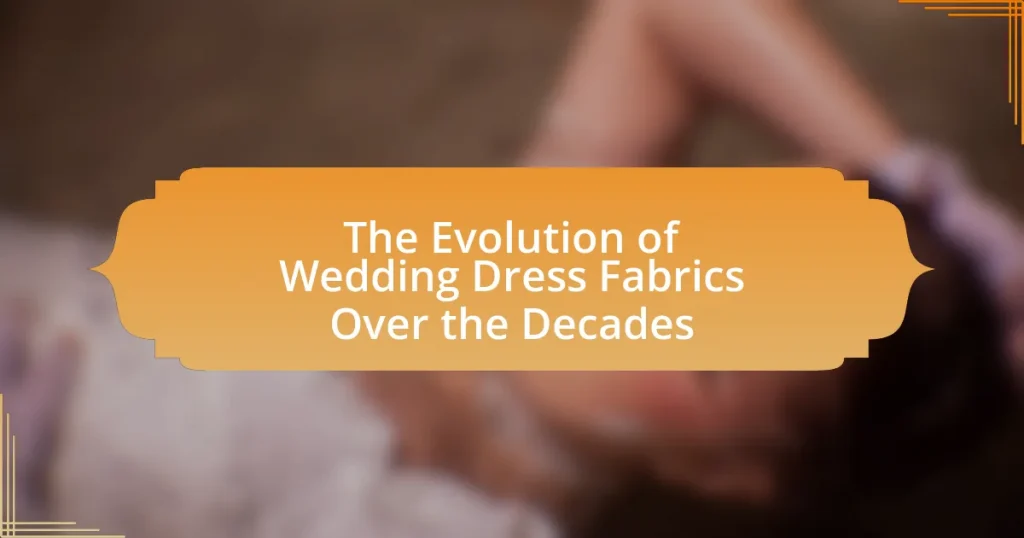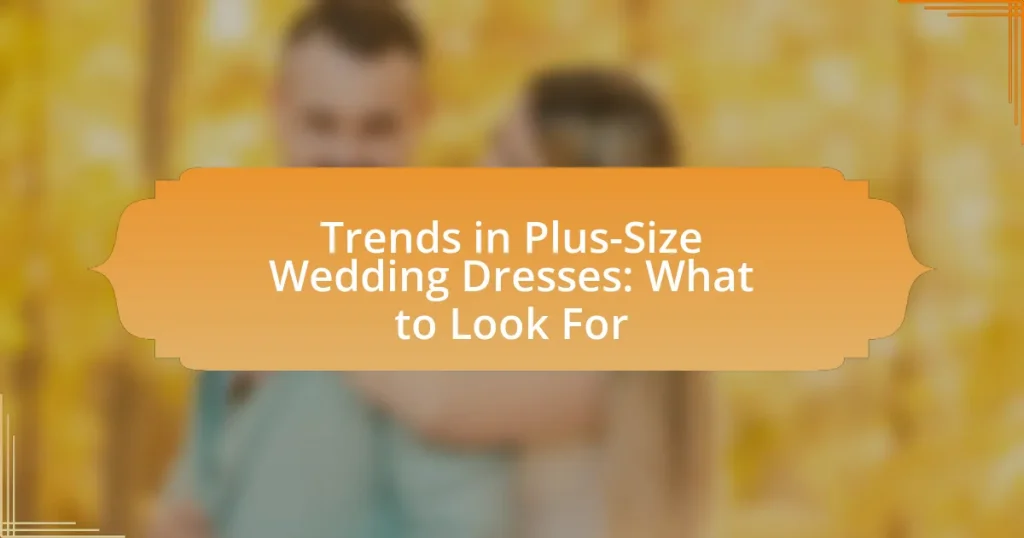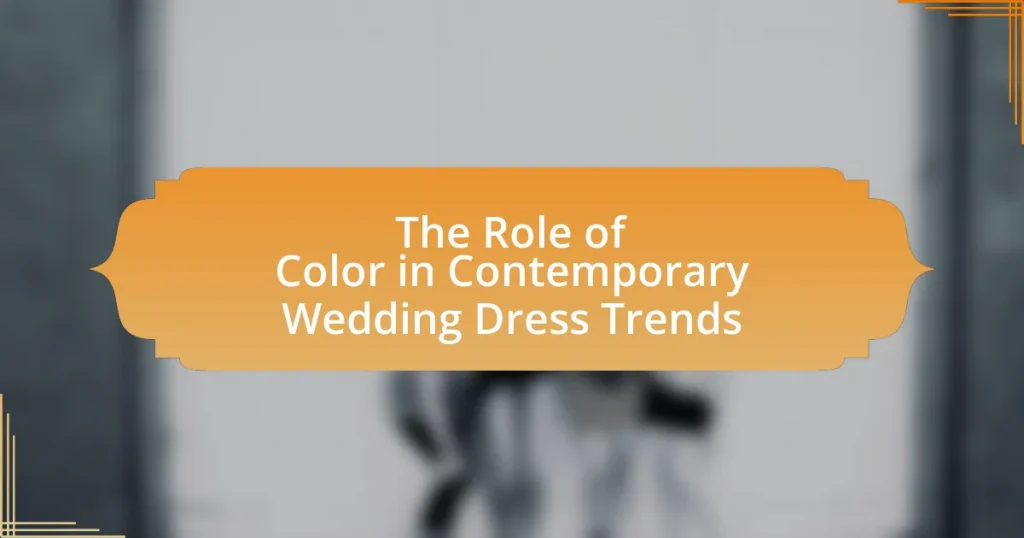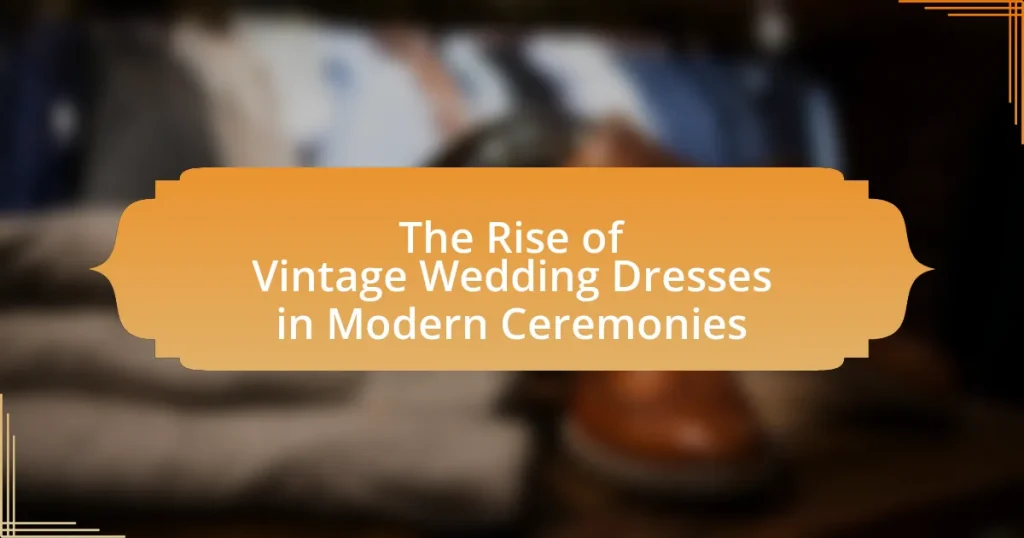The article examines the evolution of wedding dress fabrics over the decades, highlighting key historical influences such as cultural traditions, technological advancements, and social changes. It discusses the impact of royal weddings on fabric trends, the effects of the Industrial Revolution on fabric availability, and the predominant materials used in various eras, including silk, lace, and synthetic options. Additionally, the article explores how cultural shifts and economic factors, such as the Great Depression, shaped fabric choices, as well as current trends towards sustainable materials and innovative designs. Practical considerations for brides when selecting fabrics, including comfort, seasonality, and personal style, are also addressed, providing a comprehensive overview of the factors influencing wedding dress fabric choices throughout history.
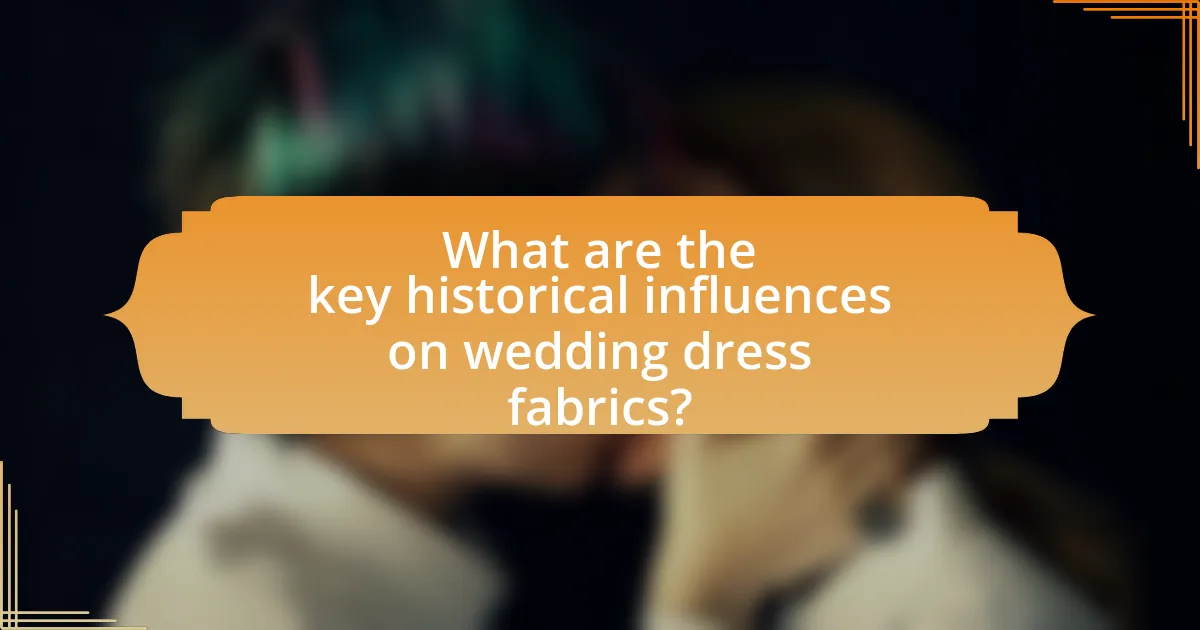
What are the key historical influences on wedding dress fabrics?
Key historical influences on wedding dress fabrics include cultural traditions, technological advancements, and social changes. For instance, the introduction of silk in the 12th century, primarily from China, revolutionized wedding attire, making luxurious fabrics accessible to the elite. The Victorian era further shaped wedding dress fabrics with Queen Victoria’s choice of white silk satin for her wedding to Prince Albert in 1840, which popularized white as a symbol of purity and led to the widespread use of similar fabrics in bridal wear. Additionally, the Industrial Revolution in the 19th century enabled mass production of textiles, allowing a broader range of fabrics, such as tulle and lace, to be used in wedding dresses. These historical events collectively influenced the materials and styles of wedding dresses, reflecting societal values and technological progress.
How did cultural shifts impact wedding dress fabric choices?
Cultural shifts significantly influenced wedding dress fabric choices by reflecting changing societal values and aesthetics. For instance, the rise of feminism in the 1960s led to a preference for more practical and less traditional fabrics, such as cotton and polyester blends, as brides sought comfort and individuality over conformity to classic styles. Additionally, the 1980s saw an embrace of opulence, with silk and satin becoming popular as symbols of wealth and status, influenced by the era’s emphasis on extravagance. Historical events, such as World War II, also impacted fabric availability, leading to the use of simpler materials like rayon due to rationing. These shifts illustrate how cultural contexts directly shaped the materials chosen for wedding dresses, aligning them with contemporary ideals and practical considerations.
What role did royal weddings play in fabric trends?
Royal weddings significantly influenced fabric trends by showcasing luxurious materials and innovative designs that set standards for bridal fashion. For instance, the wedding of Queen Victoria in 1840 popularized white silk satin, leading to its widespread adoption in wedding dresses. Similarly, the 2011 marriage of Prince William and Catherine Middleton featured a gown made of silk tulle and lace, which sparked a resurgence in the use of these fabrics among brides globally. These high-profile events not only highlight specific fabrics but also inspire designers and consumers to embrace similar styles, thereby shaping the overall market for wedding attire.
How did the industrial revolution change fabric availability?
The Industrial Revolution significantly increased fabric availability by introducing mechanized production methods. Innovations such as the spinning jenny and power loom allowed for faster and more efficient textile manufacturing, resulting in a dramatic rise in the quantity of fabrics produced. By the early 19th century, the production of cotton textiles surged, with the United Kingdom alone producing over 1 billion yards of cotton fabric annually by 1850. This mass production made fabrics more accessible and affordable, transforming the fashion industry and enabling a wider variety of materials to be used in garments, including wedding dresses.
What were the predominant fabrics used in the early 20th century?
The predominant fabrics used in the early 20th century included silk, satin, lace, and tulle. Silk was favored for its luxurious feel and drape, while satin provided a smooth, glossy finish that was popular for formal wear. Lace was often used for embellishments and overlays, adding intricate designs to garments. Tulle, a lightweight netting, was commonly employed for veils and skirts, contributing to the ethereal quality of wedding dresses during this period. These fabrics were widely available and reflected the fashion trends and social norms of the time, making them essential in the design of wedding attire.
What characteristics defined silk and lace in early wedding dresses?
Silk and lace in early wedding dresses were characterized by their luxurious texture and intricate designs. Silk provided a smooth, lustrous finish that symbolized wealth and elegance, while lace added delicate detailing and a sense of femininity. Historically, silk was favored for its ability to drape beautifully and reflect light, enhancing the overall aesthetic of the gown. Lace, often hand-crafted, featured elaborate patterns that showcased craftsmanship and artistry, making it a popular choice for embellishment. These materials not only represented social status but also played a significant role in the visual and tactile appeal of early wedding attire.
How did the Great Depression affect fabric choices for weddings?
The Great Depression significantly influenced fabric choices for weddings by leading to a preference for more affordable materials. During this economic downturn, many couples faced financial constraints, prompting them to opt for simpler, less expensive fabrics such as cotton and rayon instead of luxurious options like silk or satin. Historical accounts indicate that wedding dresses became less ornate and more practical, reflecting the economic realities of the time, as families prioritized budget-friendly choices over extravagant displays.
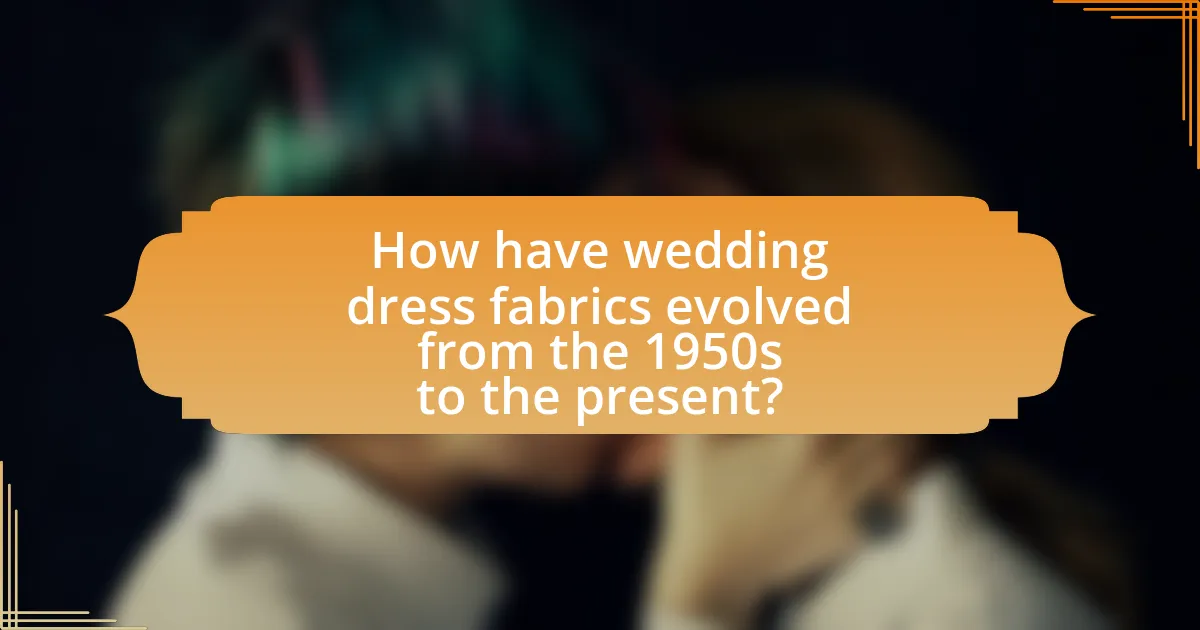
How have wedding dress fabrics evolved from the 1950s to the present?
Wedding dress fabrics have evolved significantly from the 1950s to the present, transitioning from traditional materials like silk and taffeta to a diverse range of fabrics including lace, chiffon, and sustainable options like organic cotton and recycled polyester. In the 1950s, wedding dresses predominantly featured structured silhouettes made from heavier fabrics, emphasizing a classic and formal aesthetic. By the 1970s and 1980s, lighter materials gained popularity, allowing for more fluid designs and bohemian styles. The 1990s introduced a mix of vintage-inspired lace and modern synthetics, reflecting changing fashion trends. In recent years, there has been a notable shift towards eco-friendly fabrics, driven by increased awareness of sustainability in fashion, with designers incorporating innovative materials that reduce environmental impact. This evolution illustrates a broader trend in the fashion industry towards versatility, comfort, and sustainability in wedding attire.
What fabrics became popular in the mid-20th century?
In the mid-20th century, fabrics such as polyester, nylon, and lace became popular for clothing, including wedding dresses. Polyester emerged as a favored choice due to its durability, affordability, and ease of care, while nylon was celebrated for its lightweight and silky texture. Lace, often used for overlays and detailing, added a romantic and elegant touch to bridal attire. The rise of these materials coincided with advancements in textile manufacturing, making them widely accessible and appealing to consumers during this era.
How did the rise of synthetic fabrics change wedding dress design?
The rise of synthetic fabrics significantly transformed wedding dress design by introducing versatility, affordability, and innovative styles. Synthetic materials such as polyester and nylon allowed designers to create intricate designs and textures that were previously difficult to achieve with natural fabrics. For instance, the ability to produce lightweight and wrinkle-resistant fabrics made wedding dresses more practical for various settings and climates. Additionally, synthetic fabrics often came at a lower cost, making wedding dresses more accessible to a broader range of consumers. This shift enabled a wider variety of styles, from sleek and modern silhouettes to elaborate, voluminous designs, reflecting changing societal norms and personal preferences in bridal fashion.
What influence did fashion icons have on fabric trends in the 1960s and 70s?
Fashion icons significantly influenced fabric trends in the 1960s and 70s by popularizing bold patterns, synthetic materials, and innovative designs. Designers like André Courrèges and Yves Saint Laurent introduced fabrics such as polyester and nylon, which allowed for more vibrant colors and unique textures, reflecting the era’s spirit of experimentation. Additionally, celebrities like Twiggy and Jackie Kennedy set trends that emphasized mod styles and luxurious fabrics, leading to a shift in wedding dress designs that incorporated these elements, such as the use of lace and satin in more contemporary silhouettes. This shift was evident in the rise of A-line and empire waist dresses, which became staples in bridal fashion during this period.
What are the current trends in wedding dress fabrics?
Current trends in wedding dress fabrics include the use of sustainable materials, lightweight textiles, and intricate lace designs. Sustainable fabrics, such as organic cotton and recycled polyester, are gaining popularity as couples prioritize eco-friendly choices. Lightweight textiles like chiffon and tulle are favored for their comfort and flow, allowing for ease of movement. Additionally, intricate lace remains a timeless choice, often combined with modern silhouettes to create a blend of classic and contemporary styles. These trends reflect a shift towards personalization and environmental consciousness in wedding attire.
How are sustainable fabrics shaping modern wedding dress choices?
Sustainable fabrics are significantly influencing modern wedding dress choices by promoting eco-friendly materials and ethical production practices. Designers are increasingly opting for fabrics like organic cotton, hemp, and Tencel, which reduce environmental impact compared to traditional materials. For instance, the use of organic cotton in wedding dresses can decrease water usage by up to 91% compared to conventional cotton, as reported by the Organic Trade Association. This shift not only appeals to environmentally conscious brides but also encourages a broader industry trend towards sustainability, with many brands now prioritizing transparency in their sourcing and manufacturing processes.
What innovative materials are being used in contemporary designs?
Innovative materials used in contemporary designs include sustainable fabrics like organic cotton, Tencel, and recycled polyester. These materials are gaining popularity due to their environmental benefits and versatility. For instance, Tencel, made from sustainably sourced wood pulp, is known for its softness and breathability, making it ideal for wedding dresses. Additionally, recycled polyester, derived from plastic bottles, reduces waste and offers durability. The shift towards these materials reflects a broader trend in the fashion industry prioritizing sustainability and ethical production practices.
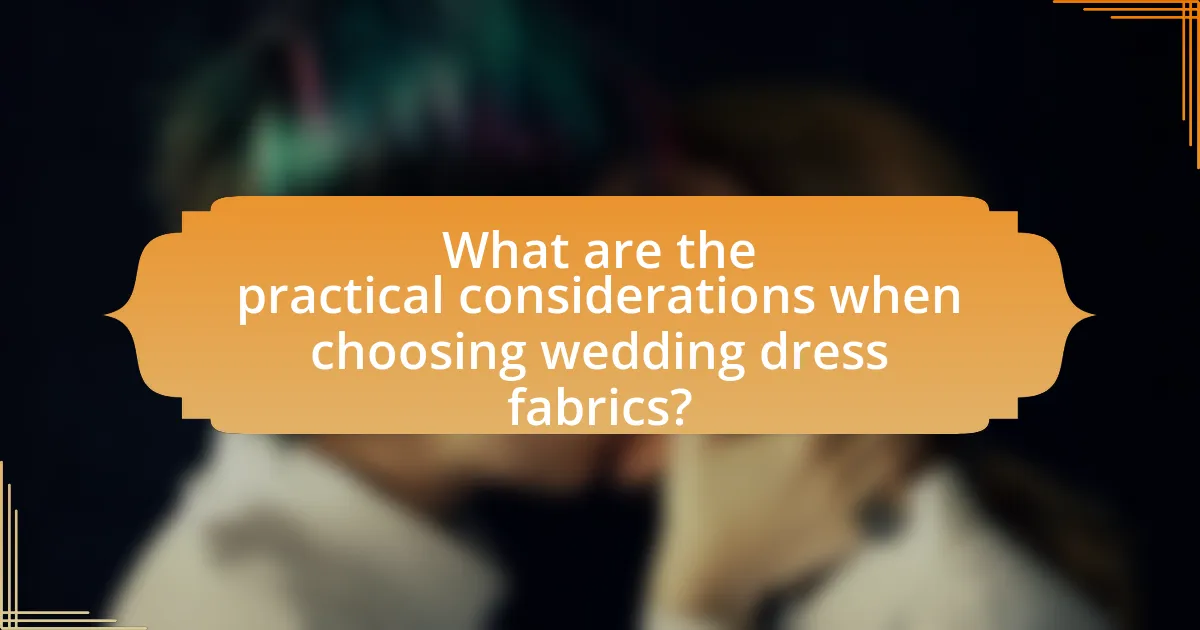
What are the practical considerations when choosing wedding dress fabrics?
When choosing wedding dress fabrics, practical considerations include the fabric’s weight, breathability, drape, and care requirements. Heavier fabrics like satin provide structure but may be less comfortable in warm weather, while lighter fabrics like chiffon offer breathability but may lack support. The drape affects how the dress falls and moves, influencing the overall silhouette. Additionally, care requirements vary; some fabrics may require dry cleaning, while others can be hand-washed, impacting long-term maintenance. Understanding these factors ensures the chosen fabric aligns with the wedding’s setting and the bride’s comfort.
How do different fabrics affect comfort and wearability?
Different fabrics significantly influence comfort and wearability by affecting breathability, stretch, and texture. For instance, natural fibers like cotton and linen provide excellent breathability, allowing air circulation that enhances comfort, especially in warm conditions. In contrast, synthetic fabrics such as polyester may trap heat, potentially leading to discomfort during extended wear. Additionally, fabrics with stretch, like spandex blends, improve fit and mobility, contributing to overall wearability. Research indicates that the choice of fabric can impact the wearer’s experience, with studies showing that 70% of individuals prioritize comfort in clothing selection, highlighting the importance of fabric choice in design.
What should brides consider regarding fabric weight and seasonality?
Brides should consider that fabric weight significantly impacts comfort and style based on the season of the wedding. For warmer months, lightweight fabrics like chiffon or organza are ideal as they allow for breathability and ease of movement, while heavier fabrics such as satin or velvet are more suitable for cooler seasons, providing warmth and a structured silhouette. Historical trends indicate that fabric choices have evolved with seasonal preferences, as seen in the popularity of lighter materials in summer weddings and richer textiles in winter ceremonies.
How do fabric choices impact the overall wedding theme?
Fabric choices significantly impact the overall wedding theme by influencing the aesthetic, mood, and style of the event. For instance, luxurious fabrics like silk and satin evoke elegance and sophistication, aligning with formal themes, while lighter materials such as chiffon and lace can create a romantic and whimsical atmosphere suitable for outdoor or vintage weddings. Historical trends show that fabric types have evolved, with the use of tulle and organza becoming popular in modern weddings, reflecting contemporary tastes and styles. This evolution illustrates how fabric not only serves a functional purpose but also plays a crucial role in conveying the desired theme and emotional tone of the celebration.
What tips can help brides select the perfect fabric for their wedding dress?
Brides can select the perfect fabric for their wedding dress by considering the dress style, season, and comfort. The style of the dress often dictates the best fabric; for example, flowing silhouettes benefit from lightweight fabrics like chiffon or organza, while structured designs may require heavier materials like satin or taffeta. Seasonal considerations are crucial; breathable fabrics such as lace or cotton are ideal for summer weddings, while warmer fabrics like velvet or brocade suit winter ceremonies. Comfort is paramount, as brides will wear the dress for an extended period; thus, selecting a fabric that allows for ease of movement and feels good against the skin is essential.
How can brides balance personal style with fabric practicality?
Brides can balance personal style with fabric practicality by selecting materials that reflect their aesthetic while ensuring comfort and functionality. For instance, lightweight fabrics like chiffon or tulle can provide a flowing silhouette that aligns with modern trends, while also being breathable and easy to move in. Additionally, incorporating structured elements with fabrics such as satin or lace can enhance the overall design without sacrificing wearability. Historical trends show that brides have increasingly favored fabrics that offer both visual appeal and comfort, as seen in the rise of minimalist designs in the 21st century, which prioritize ease of wear alongside personal expression.
What resources are available for brides to explore fabric options?
Brides can explore fabric options through various resources including bridal boutiques, fabric stores, online platforms, and wedding expos. Bridal boutiques often provide a curated selection of fabrics and expert advice, while fabric stores offer a wider range of materials for DIY projects. Online platforms like Pinterest and Instagram showcase trends and fabric ideas, and wedding expos allow brides to interact with vendors and see fabric samples in person. These resources collectively help brides make informed decisions about their wedding dress fabrics.
